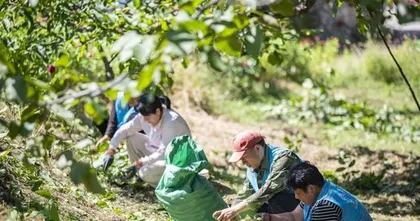The black peach tree is a relatively common fruit tree, but many people are not clear about its growth cycle and fruit planting. Let's learn about it together today.

I. Growth Cycle of the Black Peach Tree
How many years does it take for a black peach tree to grow from planting to flowering and fruiting? How to manage the black peach tree in stages? Let's find out.
The growth cycle of a black peach tree is generally 4-5 years, and it takes about 3 years from planting to flowering and fruiting. The growth process of a black peach tree can be divided into three stages: seedling stage, young tree stage, and fruiting stage.

II. Fruit Planting for Black Peach Trees
What issues should be noted when planting black peach trees for fruit? How to improve the success rate of fruiting? Let's see the introduction below.
1. Choose a good variety
First, you must choose a variety that is suitable for the local climate and soil conditions. Different varieties have different fruit ripening times, so be sure to choose the one that is right for you.

2. Pruning techniques
Pruning is one of the key factors in increasing fruit tree yield. It is important to maintain ventilation and light penetration for the branches, and control the length and number of branches to facilitate the even distribution of nutrients and water.
3. Fertilization methods
Fertilization for fruiting black peach trees should be done in moderation. Too much or too little will affect the quality and quantity of the fruit. Generally, fertilize 2-3 times during the growing season, and the amount of fertilizer each time should not be excessive.
4. Pest and disease prevention
Black peach trees need attention to prevent pests and diseases. Take timely measures to prevent and control them to ensure the quality and quantity of the fruit.
5. Watering
Black peach trees need to be watered in a timely manner, especially during the fruit development period, to ensure the fruit absorbs sufficient water and improve its quality.
III. Maintenance Methods for Black Peach Trees
The maintenance methods for black peach trees must be noted, as they play an important role in improving the quality and quantity of the fruit.
1. Pruning branches
Regular pruning of branches is a necessary measure to ensure the healthy growth of black peach trees, which can ensure sufficient light and balanced nutrition for the fruit.
2. Fertilization
Fertilization for black peach trees must use suitable fertilizers to ensure healthy fruit growth. Fertilization can be divided into base fertilizer and top dressing. Base fertilizer can be applied during planting, while top dressing should be applied timely during the growing season.
3. Maintain suitable humidity
Black peach trees need to maintain suitable humidity; neither too dry nor too wet is conducive to growth. It is important to maintain suitable soil moisture to avoid the negative effects of drought on the black peach tree.
4. Regular weeding
The area around the black peach tree needs to be weeded regularly to avoid weeds affecting its growth. At the same time, it can also increase ventilation and light penetration around the tree.
5. Pest and disease control
Black peach trees need regular inspection and control of pests and diseases, such as aphids, powdery mildew, etc. Take timely measures to prevent and control them to avoid affecting the fruit.
IV. Fruiting Time of Black Peach Trees
The fruiting time for black peach trees is generally after 4-5 years, but the specific time is also affected by factors such as climate and soil. Generally, it flowers between March and April and fruits between June and August.
V. Precautions for Black Peach Tree Fruiting
There are several aspects to pay attention to when black peach trees bear fruit.
1. Fruit picking
Black peach fruits should be picked promptly after they ripen to avoid rot or pest damage.
2. Maintain ventilation and light
After the fruit ripens, it is important to maintain ventilation and light to prevent the fruit from being eroded by mold and bacteria.
3. Storage methods
Picked black peach fruits can be stored in a cool, dry, and ventilated place, or packaged with tools like fresh-keeping bags.
4. Post-harvest pruning
After fruit picking, timely post-harvest pruning should be done to keep the branches clean and avoid affecting the growth of the next season.
VI. Factors Affecting Black Peach Tree Fruiting
The main factors affecting the fruiting of black peach trees include temperature, soil, water, light, etc. These factors will affect the quantity and quality of the fruit.
VII. Propagation Methods for Black Peach Trees
The main propagation methods for black peach trees include grafting, cuttings, and seedling cultivation. Among them, grafting and cuttings are more commonly used methods.
VIII. Introduction to Black Peach Tree Varieties
There are many varieties of black peach trees, such as Jufeng Black Peach, Hongxing, Qinghua, Yatai, etc. Different varieties have different fruit colors, tastes, and textures.
The growth cycle of a black peach tree is 4-5 years, and it takes about 3 years from planting to fruiting. Fruit planting requires attention to selecting good varieties, pruning techniques, fertilization methods, pest and disease prevention, and watering. Maintenance methods require attention to pruning branches, fertilization, maintaining suitable humidity, regular weeding, and pest and disease control. The fruiting time for black peach trees is generally after 4-5 years. After fruit picking, attention should be paid to storage methods, maintaining ventilation and light, and performing post-harvest pruning. The propagation methods for black peach trees include grafting, cuttings, and seedling cultivation. Different varieties have different fruit colors, tastes, and textures.